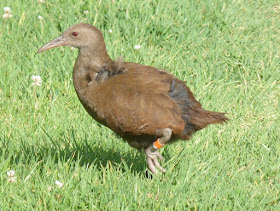I'll actually be in South America when this comes on line, but you're reading this courtesy of the magic of blogging... Today is the first day of National Bird Week in Australia, coordinated by Birdlife Australia, our national non-government bird conservation and study organisation. A little while ago I was contacted by Jack from the Aussie Backyard Bird Count, a key activity of Bird Week, to ask if I'd like to theme a blog post to support the activities, and of course I was flattered and happy to cooperate. (You can find out more about both Birdlife Australia and the Count here.)
I've decided to celebrate Australia's birds by introducing just one species from (nearly) every family of native Australian birds - in a few cases I don't have a suitable photograph but you'll meet most of the families here in three postings over the next few weeks. (I'm sure you'll notice the gaps, so I won't point them out!) Time pressures in terms of preparing to go away, and the number of families involved (over 80!) means that the coverage will be rather superficial - just regard this as a celebration of Australian birds. And as ever I make no claims to being a Photographer; my pics are definitely illustrations! The names and the order they appear in is as per the IOC list at the current time (though they are in the process of radically updating the order of Orders, as it were). I have placed some emphasis on rarer or lesser known species, but not at all exclusively.
Order Casuariiformes
Family Casuariidae; emu and cassowaries
Family Casuariidae; emu and cassowaries
Order Anseriformes
Family Anseranatidae; Magpie Goose
Family Anseranatidae; Magpie Goose
 |
| Magpie Geese Anseranas semipalmata, south of Darwin. A strange Daffy Duck lookalike, the only member of its family, neither goose nor duck, but apparently something older. |
Order Anseriformes
Family Anatidae; ducks, geese and swans
Family Anatidae; ducks, geese and swans
 |
| Green Pygmy Geese Nettapus pulchellus, Kakadu National Park. No these aren't geese either, but true ducks. |
Order Galliformes
Family Megapodidae; mound builders
Family Megapodidae; mound builders
Order Procellariiformes
Family Oceanitidae; southern storm petrels
Family Oceanitidae; southern storm petrels
Order Procellariiformes
Family Procellariidae; petrels and shearwaters
Family Procellariidae; petrels and shearwaters
Order Podicipediformes
Family Podicipedidae; grebes
Family Podicipedidae; grebes
 |
| Australasian Grebes Tachybaptus novaehollandiae on floating nest, near Canberra. An ancient world-wide group with no near relatives; heavy-bodied divers for food and safety. |
Order Phaethontiformes
Family Phaethontidae; tropicbirds
Family Phaethontidae; tropicbirds
Order Ciconiiformes
Family Ciconiidae; storks
Family Ciconiidae; storks
Order Pelecaniformes
Family Threskiornithidae; ibis and spoonbills
Family Threskiornithidae; ibis and spoonbills
Order Pelecaniformes
Family Ardeidae; herons and bitterns
Family Ardeidae; herons and bitterns
Order Pelecaniformes
Family Pelecanidae; pelicans
Family Pelecanidae; pelicans
Order Suliformes
Family Fregatidae; frigatebirds
Family Fregatidae; frigatebirds
Order Suliformes
Family Sulidae; gannets and boobies
Family Sulidae; gannets and boobies
Order Suliformes
Family Phalacrocoracidae; cormorants
Family Phalacrocoracidae; cormorants
Order Suliformes
Family Anhingidae; darters
Family Anhingidae; darters
Order Accipitriformes
Family Pandionidae; ospreys
Family Pandionidae; ospreys
 |
| Eastern Osprey pair Pandion cristatus, at nest, Eyre Peninsula, South Australia. There are now two osprey species recognised; they are the only day-time birds which live exclusively on fish. |
Order Accipitriformes
Family Accipitridae; hawks and eagles
Family Accipitridae; hawks and eagles
Order Otidiformes
Family Otidae; bustards
Family Otidae; bustards
Order Gruiformes
Family Rallidae; rails, crakes, swamphens etc
Family Rallidae; rails, crakes, swamphens etc
Order Gruiformes
Family Gruidae; cranes
Family Gruidae; cranes
And that's enough for today! Next time I'll finish off the non-passerine orders - I do hope you come back for that. Meantime, enjoy Bird Week - and even more importantly, keep enjoying the birds!!
NEXT POSTING THURSDAY 2 NOVEMBER
(And
remember that you can get a reminder when the next post appears by
putting your email address in the Follow by Email box in the top right
of this screen.)











































